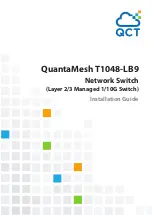
1-3
Implementation of RPF check in multicast
Implementing an RPF check on each received multicast data packet would bring a big burden to the
router. The use of a multicast forwarding table is the solution to this issue. When creating a multicast
routing entry and a multicast forwarding entry for a multicast packet, the router sets the RPF interface of
the packet as the incoming interface of the (S, G) entry. Upon receiving an (S, G) multicast packet, the
router first searches its multicast forwarding table:
1) If the corresponding (S, G) entry does not exist in the multicast forwarding table, the packet is
subject to an RPF check. The router creates a multicast routing entry based on the relevant routing
information and adds the entry into the multicast forwarding table, with the RPF interface as the
incoming interface.
z
If the interface on which the packet actually arrived is the RPF interface, the RPF check succeeds
and the router forwards the packet to all the outgoing interfaces.
z
If the interface on which the packet actually arrived is not the RPF interface, the RPF check fails
and the router discards the packet.
2) If the corresponding (S, G) entry exists, and the interface on which the packet actually arrived is the
incoming interface, the router forwards the packet to all the outgoing interfaces.
3) If the corresponding (S, G) entry exists, but the interface on which the packet actually arrived is not
the incoming interface in the multicast forwarding table, the multicast packet is subject to an RPF
check.
z
If the RPF interface is the incoming interface of the (S, G) entry, this means the (S, G) entry is
correct but the packet arrived from a wrong path. The packet is to be discarded.
z
If the RPF interface is not the incoming interface, this means the (S, G) entry has expired, and
router replaces the incoming interface with the RPF interface. If the interface on which the packet
arrived in the RPF interface, the router forwards the packet to all the outgoing interfaces; otherwise
it discards the packet.
Assume that unicast routes are available in the network, MBGP is not configured, and no multicast
static routes have been configured on Router C, as shown in
Figure 1-1
. Multicast packets travel along
the SPT from the multicast source to the receivers. The multicast forwarding table on Router C contains
the (S, G) entry, with Vlan-interface20 as the RPF interface.
Figure 1-1
RPF check process
Summary of Contents for S7906E - Switch
Page 82: ...1 4 DeviceA interface tunnel 1 DeviceA Tunnel1 service loopback group 1...
Page 200: ...1 11 DeviceB display vlan dynamic No dynamic vlans exist...
Page 598: ...ii...
Page 1757: ...4 9...
Page 1770: ...6 4...
Page 2017: ...2 11 Figure 2 3 SFTP client interface...
Page 2238: ...1 16 DeviceA cfd linktrace service instance 1 mep 1001 target mep 4002...
















































